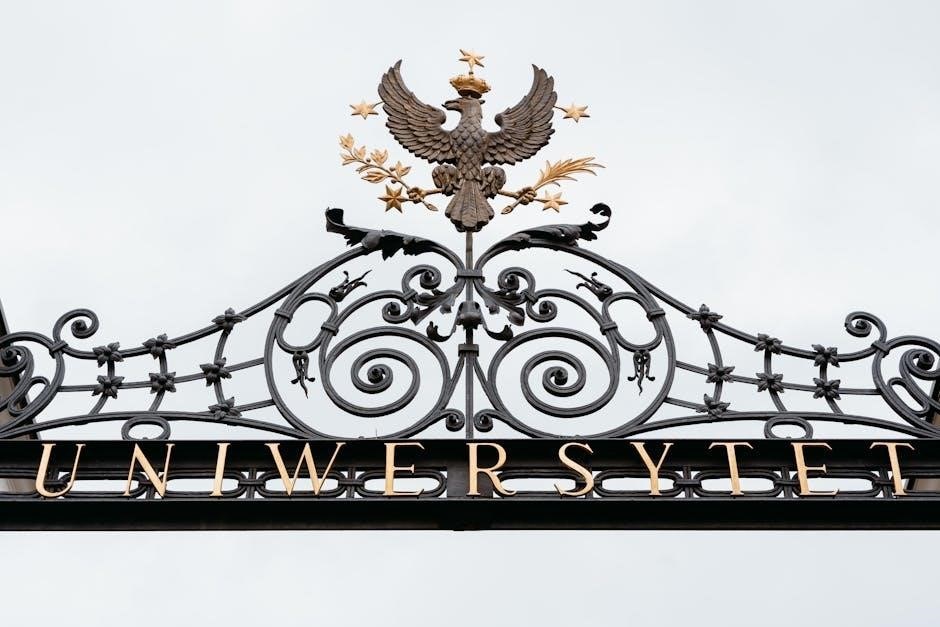the underground railroad pdf colson whitehead
Colson Whitehead’s The Underground Railroad is a gripping novel that reimagines the journey of Cora‚ a young enslaved woman escaping a Georgia plantation. Published in 2016‚ it won the Pulitzer Prize and was selected by Oprah’s Book Club‚ acclaiming its powerful portrayal of slavery‚ freedom‚ and resilience. The story blends historical facts with magical realism‚ offering a unique perspective on America’s past. Cora’s harrowing escape‚ aided by Caesar‚ explores themes of identity‚ oppression‚ and the elusive American Dream‚ making it a landmark in contemporary literature.
Background of the Novel
The Underground Railroad by Colson Whitehead is a monumental work of historical fiction published in 2016. Set in the 19th century‚ the novel reimagines the harrowing journey of Cora‚ a young enslaved woman fleeing a Georgia plantation. Drawing from the brutal realities of slavery‚ Whitehead crafts a narrative that blends historical facts with magical realism‚ depicting the Underground Railroad as a literal network of secret tracks and stations. The novel explores themes of freedom‚ identity‚ and the enduring legacy of oppression. Its publication was met with critical acclaim‚ earning the Pulitzer Prize for Fiction in 2017 and becoming a selection for Oprah’s Book Club. Whitehead’s unique approach to storytelling has made the novel a defining work in contemporary African American literature.
Colson Whitehead’s Inspiration
Colson Whitehead’s inspiration for The Underground Railroad stemmed from his childhood fascination with the idea of the Underground Railroad as a literal network. He was surprised to learn it wasn’t a real subway system but a metaphor for escape routes. Whitehead drew from historical accounts of slavery and the resilience of African Americans‚ blending them with magical realism to create a unique narrative. His personal experiences and exploration of race and identity in America further influenced the novel. Whitehead aimed to shed light on the brutal realities of slavery while celebrating the human spirit’s capacity for survival and hope. The novel reflects his deep research and imaginative reinterpretation of history‚ making it a powerful contribution to African American literature.
Historical Context of the Underground Railroad
The Underground Railroad was a network of secret routes and safe houses used by enslaved African Americans in the 19th century to escape to freedom in the Northern states and Canada. Active from the 17th to the 19th century‚ it was a critical part of the abolitionist movement‚ aiding thousands in their pursuit of liberty. The Fugitive Slave Act of 1793 and the Kansas-Nebraska Act of 1854 intensified the risks for escapees and those who assisted them. Colson Whitehead’s novel reimagines this history‚ blending factual events with fictional elements to highlight the brutality of slavery and the resilience of those who sought freedom. The historical context underscores the novel’s themes of oppression‚ survival‚ and the enduring quest for liberation.

Plot Summary of The Underground Railroad
Cora‚ a young enslaved woman‚ escapes a Georgia plantation with Caesar’s help‚ using the Underground Railroad‚ reimagined as a literal railroad‚ to flee brutal slavery and relentless pursuers.
Cora’s Journey from Georgia to Freedom
Cora‚ a young enslaved woman‚ embarks on a perilous journey from a Georgia plantation‚ escaping the brutal conditions of slavery. With the help of Caesar‚ she discovers the Underground Railroad‚ reimagined as a literal network of secret tracks and stations. Her journey is marked by both hope and horror as she navigates the treacherous path to freedom. Traveling through states like South Carolina‚ North Carolina‚ and Indiana‚ Cora encounters diverse forms of oppression and deception. Each stop reveals the harsh realities of racism and the illusion of freedom in the North. Cora’s resilience is tested by relentless pursuers‚ particularly the ruthless slave catcher Ridgeway. Her story is a powerful exploration of survival‚ identity‚ and the enduring quest for liberation. Cora’s journey is not just physical but also emotional‚ as she grapples with the legacy of her mother’s abandonment and the fragments of her own identity. Through her travels‚ Cora uncovers the painful truths of American history and the enduring strength of the human spirit. Ultimately‚ her journey is a testament to the resilience of those who dared to seek freedom in a world determined to deny it.
The Role of Caesar in the Escape
Caesar‚ a fellow enslaved worker‚ plays a pivotal role in Cora’s escape by introducing her to the Underground Railroad. His audacity and determination to flee the plantation inspire Cora to join him‚ despite her initial hesitation. Caesar’s knowledge of the Railroad’s network and his ability to navigate its hidden paths prove crucial in their early journey. His unwavering resolve to reach freedom motivates Cora‚ even as they face countless dangers. However‚ Caesar’s optimism often clashes with the harsh realities they encounter‚ revealing both his courage and vulnerability. His role not only facilitates Cora’s escape but also underscores the importance of solidarity and shared resilience in the face of oppression. Caesar’s influence on Cora’s journey is profound‚ shaping her understanding of freedom and survival.
Challenges Faced by Cora and Caesar
Cora and Caesar encountered relentless obstacles during their escape‚ navigating treacherous landscapes and avoiding ruthless slave catchers like Ridgeway. The physical toll of constant travel‚ combined with the psychological strain of living in fear‚ tested their resolve. They faced limited resources‚ relying on the secretive network of the Underground Railroad for survival. Trust became a scarce commodity‚ as betrayal lurked in every interaction. Additionally‚ their differing perspectives—Cora’s pragmatism versus Caesar’s optimism—created tension‚ highlighting the complexity of their bond. The duo’s journey was a grueling test of endurance‚ resilience‚ and hope‚ as they sought freedom in a world determined to deny it to them. Their challenges underscored the brutal reality of escaping slavery in 19th-century America.

Character Analysis
Cora embodies resilience and determination as she seeks freedom. Caesar’s charisma sparks their escape. Ridgeway’s relentless pursuit embodies oppression. Mabel’s absence shapes Cora’s journey profoundly.
Cora: The Protagonist’s Struggle and Strength
Cora‚ the protagonist of The Underground Railroad‚ exemplifies resilience and determination in the face of relentless oppression. Born into slavery on a Georgia plantation‚ she endures unimaginable hardship‚ yet her desire for freedom drives her forward. Cora’s journey is marked by both physical and emotional struggles‚ as she grapples with the legacy of her mother’s abandonment and the brutality of slavery. Despite the risks‚ she seizes the opportunity to escape‚ showcasing her courage and resourcefulness. Through her experiences‚ Whitehead portrays Cora not as a victim but as a survivor‚ whose strength lies in her ability to adapt and persevere. Her story serves as a powerful exploration of identity‚ freedom‚ and the human spirit’s capacity to endure.
Caesar: The Catalyst for Escape
Caesar‚ a fellow enslaved individual‚ plays a pivotal role in Cora’s journey by presenting her with the opportunity to escape. His charismatic personality and unwavering belief in the possibility of freedom make him a compelling figure. Despite the risks‚ Caesar’s determination to flee Georgia and his confidence in the Underground Railroad’s existence inspire Cora to join him. His background‚ shaped by the harsh realities of slavery in Virginia‚ fuels his resolve to seek liberation. Caesar’s boldness and willingness to confront danger serve as the catalyst for their escape‚ setting the story’s events into motion. His character represents the resilience and hope that define the struggle for freedom.
Ridgeway: The Relentless Slave Catcher
Ridgeway‚ the ruthless slave catcher‚ embodies the brutal system of oppression that Cora and others endure. Driven by a personal vendetta‚ he is relentless in his pursuit of escaped slaves‚ particularly Cora‚ who managed to evade him once. His obsession with capturing her stems from a deep-seated pride and a twisted sense of duty to uphold the institution of slavery. Ridgeway’s character highlights the moral ambiguity of those complicit in the slave trade‚ as he often justifies his actions with a distorted sense of order and justice. His relentless pursuit adds a layer of tension to Cora’s journey‚ symbolizing the constant threat of recapture and oppression faced by enslaved individuals seeking freedom.
Mabel: Cora’s Mother and Her Legacy
Mabel‚ Cora’s mother‚ plays a pivotal role in shaping Cora’s identity and determination. Her decision to escape from the plantation before Cora was born leaves a profound impact on her daughter. Cora struggles with feelings of abandonment and admiration for her mother’s courage. Mabel’s escape is a mystery‚ with rumors of her reaching freedom in the North‚ inspiring Cora’s own quest for liberty. Despite her absence‚ Mabel’s legacy lives on through Cora‚ symbolizing resilience and the unyielding desire for freedom. Her story serves as both a source of pain and motivation for Cora‚ highlighting the complex emotional toll of slavery on families and the enduring power of maternal love.

Themes in The Underground Railroad
The novel explores themes of freedom‚ slavery’s brutality‚ identity‚ and the illusion of the American Dream‚ delving into the resilience and humanity of oppressed individuals.
Freedom and the Pursuit of Liberty
Freedom and the pursuit of liberty are central themes in The Underground Railroad‚ as Cora’s journey embodies the relentless struggle for liberation from slavery’s grip. Whitehead vividly portrays freedom as both a tangible goal and an elusive dream‚ highlighting the physical and emotional barriers enslaved individuals faced. Cora’s escape from Georgia symbolizes the universal human desire for autonomy‚ while the novel’s reimagined Underground Railroad serves as a powerful metaphor for the hidden pathways to freedom. Through Cora’s experiences‚ Whitehead underscores the paradox of freedom in America—its promise often overshadowed by the realities of oppression. The novel challenges readers to confront the enduring quest for liberty and its profound resonance in American history.
The Brutality of Slavery and Oppression
The brutality of slavery and oppression is a harrowing theme in The Underground Railroad‚ as Whitehead vividly portrays the physical‚ emotional‚ and psychological toll of enslavement. Cora and other characters endure relentless violence‚ from whippings to lynchings‚ illustrating the inhumane treatment of enslaved people. The novel exposes the systemic dehumanization perpetuated by slave owners and society‚ emphasizing the terror of living under constant threat. Whitehead also highlights the psychological scars‚ such as Cora’s trauma from her mother’s abandonment and the oppressive fear instilled by slave catchers like Ridgeway. The novel serves as a stark reminder of slavery’s barbarity and its enduring impact on individuals and communities‚ challenging readers to confront the horrors of America’s past.
Identity and Self-Discovery
Identity and self-discovery are central themes in The Underground Railroad‚ as Cora’s journey symbolizes not only a physical escape but also a search for self. Born into slavery‚ Cora’s identity is fragmented‚ shaped by the trauma of her mother’s abandonment and the dehumanizing conditions of enslavement. As she travels‚ she grapples with her past‚ questioning her worth and the legacy of slavery that defines her. Each state she visits offers a different vision of freedom and identity‚ forcing Cora to confront the contradictions of American ideals. Through her struggles‚ Whitehead explores the resilience of African Americans in reclaiming their identities and the enduring quest for selfhood in the face of systemic oppression. Cora’s story becomes a powerful metaphor for the ongoing search for justice and belonging.
The American Dream and Its Illusions
The American Dream‚ often symbolized by freedom‚ equality‚ and opportunity‚ is starkly contrasted with the harsh realities of slavery and racism in The Underground Railroad. Cora’s journey reveals the illusion of liberty‚ as even in free states‚ Black Americans face exploitation and marginalization. Whitehead critiques the notion of a unified American identity‚ exposing the hypocrisy of a nation founded on freedom yet built on oppression. The novel highlights the enduring struggle for true equality‚ showing how the pursuit of the American Dream remains elusive for many. Through Cora’s experiences‚ Whitehead challenges readers to confront the gap between the nation’s ideals and its history of injustice‚ underscoring the resilience of those who continue to seek a dream often denied.

Literary Style and Structure

Colson Whitehead’s The Underground Railroad employs a non-linear narrative‚ blending historical fiction with magical realism. His concise‚ evocative prose creates a haunting yet powerful portrayal of slavery’s atrocities‚ enhancing the emotional depth and historical gravity of Cora’s journey.
Non-Linear Narrative and Multiple Perspectives
Colson Whitehead’s The Underground Railroad features a non-linear narrative‚ weaving together fragments of Cora’s past‚ present‚ and future. This structure mirrors the chaos and disjointedness of slavery‚ emphasizing the fractured lives of enslaved individuals. The novel also employs multiple perspectives‚ shifting between Cora‚ Caesar‚ and even secondary characters like Ridgeway‚ to provide a multifaceted view of the story. This technique allows Whitehead to explore themes of identity‚ freedom‚ and oppression from various angles‚ creating a rich and layered narrative. The non-linear style and diverse viewpoints heighten the emotional impact‚ offering readers a deeper understanding of the characters’ motivations and the historical context of the Underground Railroad.
Use of Magical Realism
Colson Whitehead’s The Underground Railroad incorporates magical realism by reimagining the historical network of secret routes as a literal underground train system. This inventive approach blends fantasy with the brutal realities of slavery‚ creating a haunting yet hopeful narrative. The railroad‚ depicted as a physical‚ mystical infrastructure‚ symbolizes the ingenuity and resilience of enslaved individuals seeking freedom. This magical element contrasts sharply with the unflinching portrayal of slavery’s horrors‚ emphasizing the duality of escape and oppression. Whitehead’s use of magical realism allows readers to engage with the emotional and psychological depth of Cora’s journey while reflecting on the broader themes of liberation and identity.
Whitehead’s Prose and Language
Colson Whitehead’s prose in The Underground Railroad is both concise and evocative‚ creating a narrative that is as haunting as it is lyrical. His language is precise‚ yet layered with emotional depth‚ allowing readers to connect deeply with Cora’s journey. Whitehead avoids overly elaborate descriptions‚ instead opting for a straightforward yet powerful style that amplifies the brutality and beauty of the story. His use of vivid imagery and sparse yet impactful dialogue underscores the harsh realities of slavery while also highlighting moments of hope and resilience. The prose is both accessible and profound‚ making the novel a compelling read while ensuring its themes resonate long after the final page.

Reception and Impact
The Underground Railroad was a cultural phenomenon‚ praised for its unflinching portrayal of slavery and its innovative storytelling. It became a bestseller and sparked widespread discussions about race and history‚ solidifying its place as a modern classic.
Oprah’s Book Club Selection
Oprah Winfrey selected The Underground Railroad for her Book Club in 2016‚ catapulting it to even greater popularity. This endorsement significantly boosted its visibility‚ drawing in new readers and sparking national conversations about race‚ history‚ and justice. Oprah praised the novel for its vivid storytelling and unflinching portrayal of slavery‚ calling it a “game-changer.” The selection led to a surge in sales‚ solidifying the book’s status as a cultural phenomenon. Winfrey’s influence also brought the novel to television‚ as her production company adapted it into a highly acclaimed series. Her endorsement not only highlighted Whitehead’s brilliance but also ensured the book’s themes resonated with a broader audience‚ fostering essential discussions about America’s past and present. Oprah’s seal of approval remains a pivotal moment in the novel’s legacy.
Pulitzer Prize Win and Critical Acclaim
The Underground Railroad earned widespread critical acclaim‚ culminating in Colson Whitehead winning the Pulitzer Prize for Fiction in 2017. The novel was also awarded the National Book Award for Fiction in 2016‚ solidifying its place as a landmark work in contemporary literature. Critics praised Whitehead’s innovative storytelling‚ blending historical fiction with elements of magical realism to depict the harrowing journey of Cora‚ a young enslaved woman. The book was celebrated for its unflinching portrayal of slavery’s brutality and its exploration of freedom as both a literal and metaphorical concept. With its vivid prose and profound themes‚ The Underground Railroad became a bestseller and sparked essential conversations about race‚ history‚ and justice in America. Its success underscored Whitehead’s mastery of language and narrative structure‚ cementing his reputation as a leading literary voice.
Public Response and Popularity
Colson Whitehead’s The Underground Railroad garnered immense public attention and popularity upon its release. The novel became a New York Times bestseller and was widely discussed in literary circles and beyond. Its selection by Oprah Winfrey for her Book Club in 2016 further amplified its reach‚ introducing the book to a broader audience. Readers praised the novel for its powerful storytelling and unflinching portrayal of slavery. The book’s popularity led to a television adaptation directed by Barry Jenkins‚ which premiered on Amazon Prime in 2021. This adaptation brought Cora’s journey to a new medium‚ reinforcing the novel’s cultural impact. The public’s embrace of The Underground Railroad highlighted its relevance in contemporary discussions of race‚ freedom‚ and identity‚ ensuring its place as a modern classic.

Historical Accuracy and Creative Liberties
Whitehead blends historical facts with imaginative elements‚ creating a vivid portrayal of slavery while taking creative liberties to enhance the narrative’s emotional and thematic depth.
Portrayal of Slavery in the 19th Century
Colson Whitehead’s The Underground Railroad offers a harrowing and accurate depiction of slavery in 19th-century America‚ capturing the brutal conditions and dehumanizing treatment of enslaved people. The novel vividly portrays the physical and emotional toll of plantation life‚ including forced labor‚ violent punishments‚ and the constant threat of separation from loved ones. Whitehead emphasizes the psychological trauma inflicted by slavery‚ such as the erasure of identity and culture‚ while also highlighting the resilience and resistance of enslaved individuals. The narrative avoids romanticizing the era‚ instead presenting a raw and unflinching view of the horrors of slavery. This portrayal is both historically grounded and deeply humanizing‚ ensuring that the voices and experiences of the enslaved are not silenced or diminished.
The Underground Railroad as a Metaphor
Colson Whitehead transforms the Underground Railroad into a powerful metaphor‚ blending history with magical realism to symbolize the journey toward freedom and self-discovery. The railroad‚ depicted as a literal network of secret tracks and stations‚ represents the hidden pathways to liberation and the resilience of the human spirit. Beyond its historical context‚ it serves as a metaphor for the broader struggle against oppression‚ hope‚ and the pursuit of identity. The railroad’s unpredictability and danger mirror the uncertainties faced by enslaved individuals‚ while its existence symbolizes the enduring desire for freedom and dignity. This metaphor elevates the novel beyond a historical narrative‚ making it a timeless exploration of liberation and the universal human quest for autonomy and justice.
Whitehead’s Research and Sources
Colson Whitehead conducted extensive research to craft The Underground Railroad‚ drawing from historical documents‚ slave narratives‚ and accounts of the 19th-century African American experience. He studied the testimonies of former slaves like Frederick Douglass and Harriet Jacobs‚ as well as historical texts detailing the operations of the Underground Railroad. Whitehead also explored the brutality of slavery through records of plantation life and the experiences of enslaved individuals. His research ensured the novel’s historical accuracy‚ while his creative liberties‚ such as the literal railroad‚ allowed him to explore deeper themes. This meticulous study enabled Whitehead to authentically portray the emotional and psychological toll of slavery‚ grounding the novel in reality while elevating its narrative through imaginative storytelling.

Cultural Significance
The Underground Railroad holds profound cultural significance‚ offering a powerful exploration of slavery‚ race‚ and freedom in America. It has become a landmark in African American literature‚ sparking vital conversations about history‚ identity‚ and justice. Whitehead’s work challenges readers to confront the nation’s past while reflecting on its ongoing impact. The novel’s success has expanded its reach‚ influencing contemporary discussions on race and inequality‚ cementing its role as a cultural touchstone for understanding America’s complex legacy.

Contribution to African American Literature
The Underground Railroad has significantly enriched African American literature by reimagining the history of slavery and escape with lyrical prose and unflinching honesty. Whitehead’s novel challenges traditional narratives‚ blending historical fact with speculative fiction to create a unique voice. It has revitalized discussions about the legacy of slavery and its enduring impact on Black identity. By centering Cora’s story‚ the book offers a deeply personal exploration of resilience and freedom‚ resonating with themes central to African American literature. Its Pulitzer Prize win and widespread acclaim have cemented its place as a modern classic‚ influencing contemporary writers and readers alike. The novel’s innovative storytelling has expanded the possibilities of historical fiction‚ ensuring its lasting impact on the literary canon.
Modern Relevance of the Novel’s Themes
The Underground Railroad resonates deeply with contemporary issues‚ offering a haunting reflection on the legacy of slavery and systemic racism. Themes of oppression‚ freedom‚ and identity remain urgent in modern society‚ where racial disparities persist in justice‚ education‚ and economic systems. The novel’s exploration of bodily autonomy‚ particularly for Black women‚ aligns with current discussions around reproductive rights and gender equality. Its portrayal of collective resistance and solidarity echoes movements like Black Lives Matter‚ highlighting the ongoing struggle for liberation. By connecting past and present‚ Whitehead’s work challenges readers to confront the enduring impact of slavery and the illusion of freedom‚ fostering a deeper understanding of America’s unresolved racial tensions.
Influence on Contemporary Discussions of Race
The Underground Railroad has significantly shaped modern conversations about race‚ slavery‚ and systemic oppression. By reimagining the historical narrative of the Underground Railroad‚ Colson Whitehead forces readers to confront the brutal realities of America’s past and their lingering effects on today’s society. The novel’s vivid portrayal of racial violence and resilience has sparked widespread discussions about the legacy of slavery and its manifestations in contemporary issues like police brutality‚ mass incarceration‚ and economic inequality. It has also inspired new perspectives on how race is represented in literature and media‚ encouraging a more nuanced exploration of Black experiences. Whitehead’s work continues to be a catalyst for dialogue‚ fostering greater empathy and understanding in an era of ongoing racial tensions.
The Underground Railroad offers a powerful exploration of slavery‚ freedom‚ and identity. For further reading‚ explore works like Beloved by Toni Morrison or Between the World and Me by Ta-Nehisi Coates.
Final Thoughts on The Underground Railroad
The Underground Railroad by Colson Whitehead is a haunting yet powerful exploration of slavery‚ freedom‚ and resilience. Through Cora’s journey‚ Whitehead masterfully blends historical fiction with magical realism‚ creating a narrative that resonates deeply. The novel sheds light on the brutal realities of slavery while celebrating the strength and determination of those who sought liberation; Its vivid storytelling and unflinching honesty have made it a landmark work in contemporary literature. Readers are left to reflect on the enduring legacy of slavery and the ongoing pursuit of true freedom and equality. This Pulitzer Prize-winning novel remains a vital read for understanding America’s past and its present.
Recommended Companion Reads
Readers who appreciated The Underground Railroad may enjoy other works that explore themes of race‚ history‚ and freedom. Beloved by Toni Morrison delves into the haunting legacy of slavery through a ghostly narrative. Between the World and Me by Ta-Nehisi Coates offers a modern perspective on race in America. Homegoing by Yaa Gyasi traces the descendants of two enslaved sisters‚ highlighting the transatlantic slave trade’s impact. The Nickel Boys by Colson Whitehead himself examines the horrors of a reform school for Black boys in the 20th century. These books complement Whitehead’s work by offering deeper insights into the experiences of Black Americans and the ongoing struggle for justice and equality.
Resources for Further Study
For deeper exploration of The Underground Railroad‚ readers can delve into historical texts and critical analyses; The Underground Railroad: A Novel by Colson Whitehead is complemented by The African Americans: Many Rivers to Cross‚ a documentary series by Henry Louis Gates Jr.‚ which provides historical context on slavery and freedom. Academic articles on JSTOR and Google Scholar offer insights into the novel’s themes and historical accuracy. Additionally‚ 12 Years a Slave by Solomon Northup and Incidents in the Life of a Slave Girl by Harriet Jacobs provide firsthand accounts of slavery. The National Park Service’s website offers resources on the historical Underground Railroad‚ while The New York Times features interviews with Whitehead‚ shedding light on his creative process.


